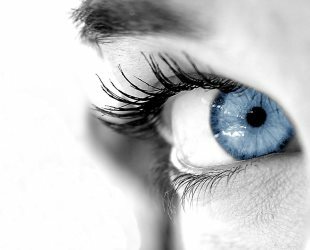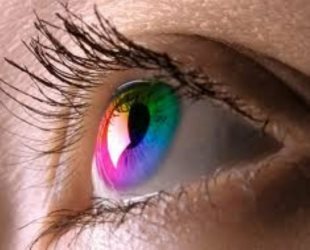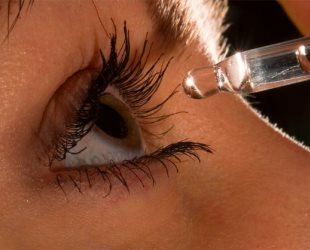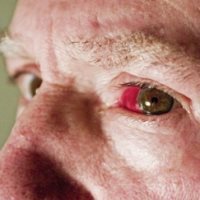
Dry eye syndrome is called a complex disease, based on a violation of moisturizing the cornea, which causes its drying and malfunctioning.
This reduces the quality or quantity of tear fluid, which forms a tear film on the conjunctival surface, which performs a protective function.
Dry eye syndrome is considered to be a disease of civilization, since the progress is significant in its appearance: conditioners, computers, televisions, etc.
Also a large prevalence of this disease is caused by environmental pollution and the use of some unsuitable medical and cosmetic means.
- 1. Causes of
- 2. Development of the disease
- 3. Symptoms of
- 4. Diagnosis of the disease
- 5. Treatment of
- 6. Prevention of
Causes of
This syndrome can develop as a separate disease and can sometimes be a consequencesome kind of disease. Despite the cause of dry eye syndrome, care must be taken to prevent and treat it, otherwise it may lead to a decrease or loss of vision.
There are many reasons for the appearance and development of dry eye syndrome, but it is necessary to know them for the prevention and prevention of disease:

Very unpleasant eyelid disease - ptosis of the upper eyelid, the article describes the disease, complex treatment and prevention methods.
Records of the ophthalmologist( here) about the nystagmus of the eyes. How to diagnose and prescribe the right treatment for the patient.
- deformation of the surface of the cornea, which leads to a violation of the tear film;
- corneal nutrition disorder;
- incomplete closure of the eyelids or excessive opening of the eye gap due to eye diseases;
- disorders in the lacrimal gland;
- vitamin deficiency;
- endocrine diseases;
- hormonal failure during menopause;
- Parkinson's disease;
- violation of the glands of the century;
- facial paralysis;
- unsuitable lenses;
- incorrect operation of the computer;
- eye surgery and improperly selected medications;
- adverse environmental factors.
Development of the disease

Normally there is a constant moistening of the eyes due to the presence of a protective tear film, which produces the tear liquid necessary for moistening the cornea. Tear film consists of several layers:
- surface layer, which consists of the fats necessary to prevent evaporation of the liquid;
- is the median layer that consists directly of the tear fluid and provides nutrition, as well as protecting the cornea;
- is a mucous layer that fits snugly against the cornea and protects it, and is also the basis for the two upper layers.
The lacrimal fluid is produced by several glands, has a complex structure and is contained in a small amount in the eye constantly, when blinking, washing it. If, during emotional experiences, the amount of tear fluid increases, its excess through the tear ducts go through the nose, which is noticeable when there is discharge from the nose when a person cries. If there are failures during any stage of tear fluid formation or distribution, dry eye syndrome occurs.
Failures can occur at the stage of lacrimal fluid production or at the stage of tear film formation( for example, when a certain layer of it is thinned or the protective film is distributed on the surface of the cornea unevenly).
Symptoms of
Dry eye syndrome is characterized by the following signs or symptoms:
- sensation in the eye of the foreign body, which leads to increased lacrimation( although it is paradoxical, but it is so), which then causes a feeling of dryness;
- decrease or absence of lacrimal menisci at the edges of the eyelids;
- viscous discharge from the eyes turns into mucous filaments, which causes patients discomfort;
- burning and pain in the eyes;
- redness( congestion) of the eyes, especially after their stress;
- pain after using eye drops, even if they do not contain irritant components;
- poor tolerance of smoke, wind, bright light.
Diagnosis of the disease
Timely diagnosis allows the patient to be appropriately treated. The examination of patients who develop symptoms of a "dry eye" is based on clinical methods. In some cases, the diagnosis is established or confirmed using special functional tests.
Clinical examination of the patient
With this method of diagnosis, the physician conducts the following procedures:
- Interrogation of the patient for the purpose of finding out complaints and symptoms.
- Complete history.
- Thorough examination of the edge of the eyelids, cornea with a special slit lamp.
- Conduct an ultrasound examination of the eyeball.
- Determination of the condition of the skin of the eyelids, their closure.
- Check the nature and frequency of blinking movements.
When ophthalmological examination, the expert finds out the objective signs of the appearance of the dry eye syndrome.
Biomicroscopy of the eye is performed using special diagnostic substances-dyes. When applied to the corneal fluorescein sodium defects on the surface of the epithelium are colored green. Medical dye Bengal pink color red corpse cells, as well as mucous and epithelial filaments.
Functional Diagnosis
This method of detecting the symptoms of the disease is used when the nature of the existing symptoms is unclear. It consists in the use of special samples.which allow to determine the invariability of the tear film and the amount of tears released by the eye.
- The Norn method makes it possible to determine the stability of a tear film after instillation into the eye of a medical dye.
- The Schirmer method is used to determine the total amount of tears released using a thin strip of special paper.
In some cases, a patient may need a consultation consultation of an endocrinologist, neurologist, allergist, immunologist.
Early diagnosis of dry eye syndrome is the first step towards successful treatment of the disease.
Treatment of
Treatment of Depending on the cause and severity of the disease, the treatment of dry eye syndrome is to achieve the following effect: If the cause of the dry eye syndrome is not dangerous, due only to improper work in the office at the computer, the symptoms are weak and no pathologies are detected, drops of artificial tears can help. They create a protective film on the surface of the patient's eye, which also includes a lacrimal fluid of the patient directly, if it still remains. Such drops are used regularly during the working day, every 2-3 hours. The most famous preparations are "Natural Tear", Oftagel, Korneregel, Vidisik, Solkoseril. If dry eye syndrome occurs due to some pathologies or severe forms of the disease, surgical treatment is recommended. For example, in order to prevent the flow of tear fluid, it is necessary to impose an obstruction of the lacrimal glands, i.e.cross them so that the teardrop does not exit through the nasal cavity. The same can be achieved and orthopedic way, when using a special "plug" overlap the tear duct. The second method is used more often, because it has many advantages in the form of hypoallergenic materials, absence of surgical intervention and irreversible changes. Read more about the main causes of hemorrhage in the eye, about first aid and proper care for the injured. In the article on pinguecula eyes. Description of sickness, symptoms and treatment. Treatment of folk remedies demodectic eyelids!http: //moezrenie.com/bolezni/ zabolevaniya-vek / demodekoz-vek.html For the prevention of dry eye syndrome, you must follow some simple recommendations that can prevent the appearance of the disease and its unpleasant consequences. If discomfort in the eyes occurs, do not self-medicate and consult a doctor. At the beginning of the disease it is easier to prevent dangerous consequences and completely get rid of the symptoms of dry eye syndrome. syndrome The prevention of dry eye syndrome is one of the important components in the alleviation of this disease. Japanese experts carried out a study of the effect of coffee consumption on dry eye symptoms. According to scientists, the dry eye syndrome suffers from a smaller number of people who drink a lot of coffee throughout the day. Specialists came to the conclusion that caffeine stimulates the lacrimal glands, saliva and gastric juice. The study involved 78 volunteers. Half of the participants used caffeine, and the rest - placebo. As a result of the experiment, it was found that the people who took coffee, the activity of lacrimation was much higher than in the second group.


Prevention

Study of the influence of coffee consumption on the development of the
